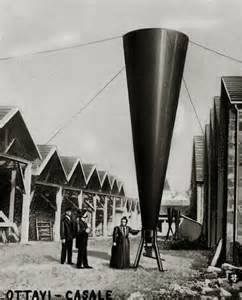Hail Cannons Mystery Cache
-
Difficulty:
-

-
Terrain:
-

Size:  (micro)
(micro)
Please note Use of geocaching.com services is subject to the terms and conditions
in our disclaimer.


In 1880, L. Bombicci, an Italian professor stated that it was conceivable that the formation of hailstones could be prevented by injecting smoke particles by means of cannons fired at thunderstorms. The concept of using cannons to provide nuclei to suppress hailstone formation was experimented by M. Stiger, an Austrian politician and a famous wine grower. He evolved a vertical-pointing muzzle loading mortar resembling a very large upright megaphone. When fired it produced a large smoke ring that, at sound level of ca. 120 dB, rose to a height of typically 300m. A test campaign with six cannons was launched in the 1896 hail season. It did not hail at all and this led to a construction of 30 cannons for the next season. Again no hail and thereby the stage was set for a wide interest in the technology. An important factor behind the interest in the cannons was of course the enormity of the hailstone induced crop losses in the wine districts in Italy, France and Austria. Already by 1899 major programs existed in four nations and the first hailstone suppression conference was held in Casale, Italy.
More than five hundred delegates came from various provinces of Germany, Italy and Austria, and all Italian ministries of the government. The conclusion of the conference was so optimistic that they raised the enthusiasm of the wine growers to a high pitch. At the end of 1900 more than 10 000 units were deployed in upper Italy with more than 9 500 000 firings taken place. However the usage was not without risk and casualties. In Venice and Brescia only for example there were reports of seven deaths and 78 injuries in 1900. An exhibit of the apparatus was held and judged during the Third International Hail Cannon Conference in Lyon 1901, see below. In the competitive trial an accident occurred that was necessitating the amputation of a right arm of an operator.
At this time several scientist started to make calculations and performed experiments with vortex rings that showed that the smoke-rings were too weak to affect the forces at cloud base. Results were also coming from areas that had been employing cannon with mixed results. The scientific doubts, the problems with fatal accidents and the evaluation uncertainties were now out in the open. The final blow came when there were major outbreaks of damaging hailstorms during 1902-1904 and many cannon protected vineyards were badly damaged. The destruction was not limited to the crop alone but was also extended to the protective hail cannons themselves as to many other man-made objects.
The use of cannons to suppress hailstone formations was largely abandoned in Europe by 1905, as they proved useless. The end had come!


Additional Hints
(No hints available.)